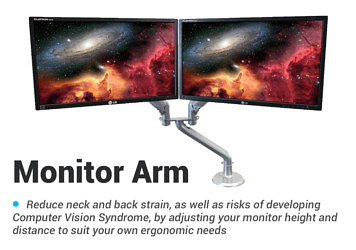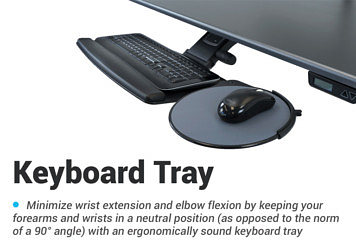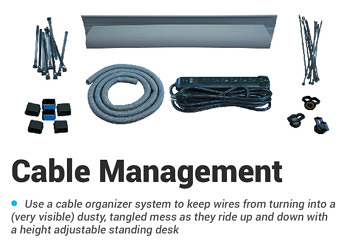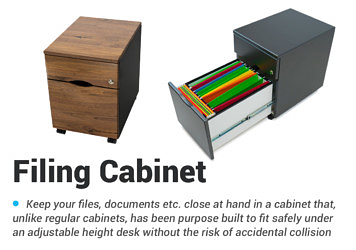How to Choose a Standing Desk Balance Board
Like most reviews sites, our editorial staff and laboratory testing expenses are partially offset by earning small commissions (at no cost to you) when you purchase something through those links. Learn More

Standing desk balance boards are steadily gaining favor and it doesn’t seem like that trend is going to end any time soon as more and more standing desk users are looking for ways to make their newly found routine even less stationary, and as a result, healthier. If you cannot afford to put a treadmill under your desk, you can get away with a desk cycle or a cheap balance board (even a pricey one will still be significantly more affordable).
As a product category, balance boards are very diverse. You can find all kinds of devices for balance training, physical therapy, and exercise on the market, with the office balance boards emerging in the last couple of years as a strong subcategory. Not every balance board, however, can accommodate the needs of a standing-desk user, so let’s see how these different products compare. And make sure you check out our full roundup of balance board reviews to see product details, ratings and more.
How to Choose a Balance Board for Standing Desk?
Office balance boards became quite popular as standing desk accessories in their own right, but how are they different from what’s already been on the market for quite some time?
If you compare them to other boards (by specs or in-person), office balance boards provide more real estate, stability, and presentable aesthetics than almost any balance trainer, rocker board, or wobble cushion the market has to offer. Their balancing mechanisms can accommodate both beginners and intermediate users, but will never get as extreme as to present a challenge for advanced sports enthusiasts.
If you are looking for a balance board that will provide you with enough movement but will not distract you from your work, be sure to consider these factors before making a choice:
- balance board type – this will depend on the type of base of your board; for instance, a hemisphere allows a board to wobble, hence the name wobble board, while a semi-circle support only offers rocking motion, which lends it its name – rocker board
- deck size – if you are tall, you might find a bigger board to be more convenient
- design – you may want a nicer looking board if you are buying it for home or the office as opposed to the gym or physical therapy clinic
- budget – balance boards come in a wide range of prices, starting as little as $20 and ending with a hefty price tag of $489
- deck material – a hard surface will quickly bring on foot pain if you plan on using your board without shoes
Types of Balance Boards
There are many types of balance boards out there – rocker boards, roller boards, and wobble boards – that can all be used for balance training. Some of them can make for great physical therapy tools and others are great devices for injecting a little more challenge into your daily workout. Most of them, however, aren’t as good for the office setting as standing desk balance boards. Office balance boards are divided into two types: rocker (only rock side to side) and wobble (allow 360-degree movement).
Ergonomic Balance Boards

So far, the only board we’ve seen of this type is the iMovR Gymba. The Gymba’s patented design effectively allows you to replicate the walking motion while standing on the board. It’s difficult to describe, but it makes sense once you see it in action. It’s essentially fluid, synchronized movement up and down between your two feet. Like walking, only without the impact or the forward movement.
This motion comes with all of the benefits we espouse for walking while working: boosting of metabolism, strengthening core muscles, improving posture, removing joint pain and inflammation, plus even improving your mood.
Rocker Boards

Featuring a semi-circle base, a typical rocker board offers two planes of instability, although you’ll only be using one at a time. Since it usually has a square deck, the board can rock either side to side or back and forth.
Typically, you’ll find such a board within a range of $20-$40 with a maximum deck size of around 20” x 20”. This is perfect for physical therapy and rehabilitation after an ankle injury or any type of leg surgery.
In the realm of office boards, Steppie would be one example of a rocker board. Gymba, although much smaller, can also provide rocking movement among other things. See our comprehensive round-up of the Best Rocker Board Reviews.
Wobble Boards

If you want more freedom of movement, a wobble board will give you a 360-degree tilt with a centered bowl-shaped base for a similar price. The deck size will vary between 15 and 20 inches.
It may be too unstable for those with balance issues but will give just the right amount of freedom to fidgety types. If you are intent on improving your balance, choose a balance board that comes with a removable base to be able to switch from rocker to wobble type whenever you feel proficient enough. A wobble board is great for physical therapy and fitness. You can also use it to improve your balance while performing your routine workout.
FluidStance decks definitely belong to the category of wobble boards as do the BackApp 360 and Gaiam’s Evolve Balance Board. See our comprehensive round-up of the Best Wobble Board Reviews.
Roller Boards (a.k.a. Balance Trainers)

While a roller board can become a playful accent in a serious office environment, it is not meant to be used with a standing desk. It provides extreme toe-heel and lateral movement, so it requires all of your focus. It is also pretty difficult to master for even experienced balance board users.
Priced between $120 and $200, such balance training system features a roller base that comes separately with the board, which makes it a perfect DIY kit. Just take a look at Indo Standing Desk Balance Board, and you’ll see how easily you can repurpose your roller board for the office with a cheap inflatable cushion. See our comprehensive round-up of the Best Roller Board Reviews.
Balance Board Tilting Degree
The higher its tilting degree, the more extreme the balance board. If you are looking for a moderate challenge in the office, a board with a 20-degree tilt should give you enough of wobble to engage your core and calf muscles. If you aren’t as comfortable with unstable surfaces, though, we’d recommend sticking to 15-degrees or lower unless you’d like to slightly improve your balance, which might take some learning.
How Important is Balance Board Size?
As a rule, the smaller the balance board the more space-restricted users feel. That’s why we wouldn’t recommend using cheaper, specialized boards, which typically come with a maximum deck size of 20 inches, with a standing desk. Sometimes in order to focus on a particularly demanding task, you have to stop balancing and assume a comfortable standing position. Here is where the bigger board size will prove useful, allowing you to assume various stances that may exceed 20 inches. Also, balancing on a smaller unstable platform is generally more challenging than on a board with a generous deck length of 25 or 30 inches, which may take away your focus from work.
The height of the board is equally important. When you are not focused on the task at hand, in this case, balancing, stepping off an unstable surface that is rather high can become a safety issue. The average height of an office balance board does not exceed 3.5 inches (Pono Board is slightly taller than that), but you may find 2-inch tall balance boards like BackApp 360 out there that pose no difficulty for hopping on and off.
Budget Balance Board Alternatives
If you are looking for less pricey alternatives for active standing, you might be tempted with balance trainers that come in the form of inflatable cushions – beware of their small sizes. Additionally, there is a higher chance to encounter product issues like air loss and puncture.
If you’re after active standing solutions that don’t involve instability, you can explore a closely related category of Calculated Terrain Mats, which are great for both standing and moving around.
How Much Does a Standing Desk Balance Board Cost?
High-quality boards can run as high as $400 dollars, but quality doesn’t always entail high price. You can find a beautiful-looking wooden Active Office Balance Board from Fitterfirst for as low as $99.95, but we do advise you to take into account factors beyond the price.
Shopping for a balance board may take a few tries if you don’t know how good (or not) you are with your balance. A more stable board may become too easy (boring even) to balance. A more extreme one, on the other hand, may have a steeper learning curve, especially for those whose balance is a bit below par. Then there is the appearance factor, which might steer you to the higher-priced balance boards designed specifically for working spaces. When it comes to balance boards specifically designed for use at an ergonomic standing desk, our staff reviewers’ top pick is the iMovR Gymba, which prices in the midrange of $229.







1 Comment
Leave a response >